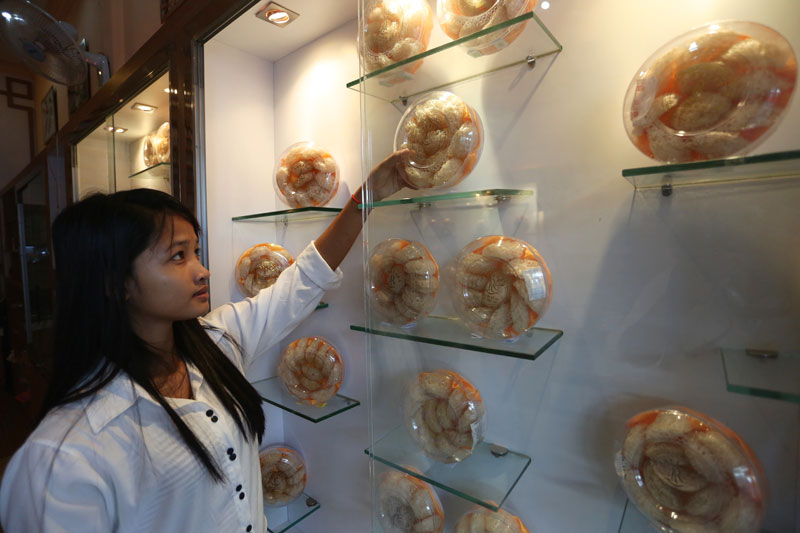Standing inside her shop behind a heavy glass door secured with an electronic lock, it would be easy to mistake Nguon Chorda for a jewelry boutique owner, not the manager of a store that sells dried bird saliva.
The Cambodia Royal Swiftlet Nest shop on Kampuchea Krom Boulevard in Phnom Penh is lined with shelves of plastic containers containing thousands of dollars’ worth of sought-after edible bird nests, and Ms. Chorda is understandably vigilant.

“These products are expensive, so we have to be careful,” she said at the shop on Monday.
The nests, which are created from the dried saliva of a species of swallow known as swiftlets, can fetch huge prices.
Ms. Chorda said her shop sells the nests for between $140 and $250 per 100 grams. In Cambodia, the nests are typically soaked in water for several hours before being stewed with rock sugar. The gelatinous mixture is then poured over ice and drunk out of a glass.
Purveyors have long promoted the supposed health benefits of consuming bird nests, claiming they can do everything from increasing libido and boosting the immune system to helping cells regenerate.
In China, where bird nests have been consumed for more than a millennium, usually in soup, they can cost more than three times what they do in Cambodia.
For this reason, the Cambodian Bird’s Nest Federation (CBNF), which formed in July, is planning to export nests harvested locally to China starting next year.
Nang Sothy, the president of the federation, has ambitious plans to jumpstart Cambodia’s nascent nest market. He hopes to gather the country’s nest farmers under one flag and convince the Ministry of Commerce to open exports of the nests to China.
“This will create jobs for 1,000 people,” Mr. Sothy said this week. “It doesn’t seem like it will be difficult for us to export swiftlet products, because they are very popular in China.”
A 2011 estimate from VinaCapital, one of the largest hedge fund managers in Vietnam—where the local and export market for edible bird nests is growing quickly—put the worth of the annual global bird nest industry at $3.4 billion. More recent estimates, including one from Mr. Sothy, value the global industry at $5 billion per year.
The vast majority of these nests are consumed in China and Hong Kong, and several countries in Southeast Asia—where swiftlets nest naturally in dark caves—are already taking advantage of the booming market.
But while swiftlet nests used to be collected in the wild, they are now generally farmed in multistory concrete structures dotted with tiny entryways. Birdsong is piped through speakers and artificial scents are sprayed throughout the building to attract the swiftlets and make them feel at home.
Mr. Sothy said once the CBNF gets off the ground, he expects the estimated 1,500 Cambodian nest farmers to export $50 million worth of nests to China annually. Currently, he said, the farmers collect about 1 ton of nests per month, selling for an average of $800 per kg.
Mao Thora, a secretary of state at the Ministry of Commerce, said his ministry will facilitate the export of nests to China by the CBNF next year, but only once the association is well established.
“Let them organize their association first,” Mr. Thora said. “We will need to inspect the conditions under which they package their products.”
Taing Kong Hav, the vice president of CBNF, also said he believes Cambodia can produce enough bird nests to export to China in bulk.
“We know of more than 1,000 bird farms,” he said. “But we don’t know for sure yet how many bird nests we can export.”
But despite China’s seemingly insatiable appetite for the nests and Cambodia’s ideal environment for the birds that produce them, not all swiftlet farmers are optimistic about Mr. Sothy’s plan.
“We can’t meet the domestic demand, so how can we export?” said Peter Chen, the owner of the shop that Ms. Chorda manages and a business partner of Mr. Kong Hav. The pair owns seven nest farms in Kampot province, Sihanoukville and Phnom Penh that, on a good month, together produce more than 50 kg of nests.
“We perhaps need to take two or three years” to develop the existing farms, he said.
Ourn Seansonal, the owner of the Swiftlet Farm Consultancy, which manages two swiftlet farms and works with interested farmers to develop their own birdhouses, said there is also a lack of people in the country with the ability to develop the industry for export.
“It is a good idea,” Mr. Seansonal said. “But who will make it happen? For me, I think it is impossible.”
Mr. Seansonal said he studied construction of swiftlet farms for three years in Malaysia. The process, he said, is not as simple as building a concrete box with holes in it.
First, significant capital is required. The cost of building the simplest swiftlet farm is $100,000, he said. On top of that, another $20,000 is needed for equipment including speakers, humidifiers and observation cameras.
Farmers also need to understand swiftlet behavior in order to attract local populations to nest in the farms.
“The birds are like humans,” he said. “If I live in Phnom Penh and another person lives in Battambang, maybe we have a little different characteristics.”
Mr. Seansonal, whose farms in Sihanoukville and Kampot produce 4 to 5 kg of nests per month, also said that Cambodia’s nest industry is not nearly as big as Mr. Sothy and Mr. Kong Hav claim. He estimates there are between 500 and 700 farms in the country, producing up to 150 kg monthly.
“Cambodia is very late to this business,” he said.